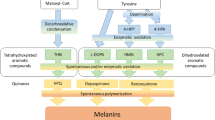Abstract
In sexual reproduction of Closterium ehrenbergii, pairing with the sexual partner cells is the first process observed. A cell migration-inducing activity, specific for mating-type plus (mt+; NIES-228) cells, was detected in the culture medium of mating-type minus (mt–; NIES-229) cells. Light was necessary for production of the active substance by mt– cells and for migration of mt+ cells. The active substance was heat-labile and had an apparent molecular mass of 20 kDa, as determined by gel filtration. A protein of 20 kDa was detected in the active fraction of gel filtration after sodium dodecyl sulfate polyacrylamide gel electrophoresis. Based on these results, it is proposed that a chemotactic sexual pheromone involved in the formation of sexual pairs of cells is secreted by mt– cells of C. ehrenbergii and is proteinaceous, like other sexual pheromones secreted by Closterium species.
Similar content being viewed by others
Author information
Authors and Affiliations
Additional information
Received: 31 July 1997 / Revision accepted: 25 November 1997
Rights and permissions
About this article
Cite this article
Fukumoto, R., Fujii, T. & Sekimoto, H. A newly identified chemotactic sexual pheromone from Closterium ehrenbergii . Sex Plant Reprod 11, 81–85 (1998). https://doi.org/10.1007/s004970050123
Issue Date:
DOI: https://doi.org/10.1007/s004970050123




